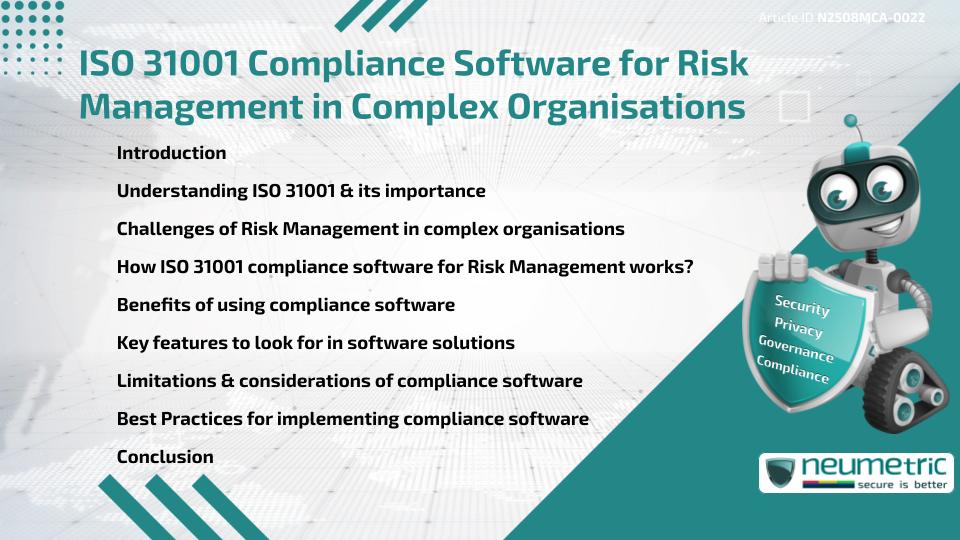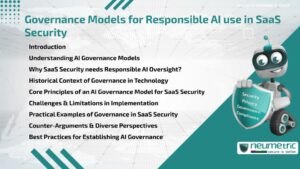Table of Contents
ToggleIntroduction
ISO 31001 compliance software for Risk Management helps complex organisations streamline their approach to identifying, assessing & mitigating Risks. It provides structured tools that align with the guidelines of ISO 31001, ensuring consistency, accountability & efficiency in managing Threats across multiple departments or regions. Complex organisations face unique challenges such as fragmented processes, overlapping responsibilities & high regulatory scrutiny. Compliance software bridges these gaps by centralising data, automating workflows & supporting better decision-making. This article explains the role of ISO 31001, the challenges of Risk Management in large organisations, the advantages of compliance software & the key practices for successful implementation.
Understanding ISO 31001 & its importance
ISO 31001 is an international Standard that outlines principles & frameworks for effective Risk Management. It emphasises that Risk Management is not just about avoiding Threats but also about identifying opportunities. For complex organisations, this Standard ensures that Risk handling is systematic & embedded into all levels of decision-making. By aligning with ISO 31001, organisations create a consistent methodology that promotes resilience & long-term sustainability.
Challenges of Risk Management in complex organisations
Managing Risk in a multinational corporation, Government agency or diversified enterprise is rarely straightforward. Challenges include:
- Silos & fragmented information: Different departments often work in isolation, leading to inconsistent data collection.
- Regulatory overload: Organisations must comply with a variety of local & international regulations.
- Scale of operations: Larger organisations have vast numbers of Stakeholders, increasing the complexity of Risk Assessment.
- Dynamic environments: Political, economic & social changes can alter the Risk landscape quickly.
Without a centralised Framework, these challenges may result in delays, errors & Financial losses.
How ISO 31001 compliance software for Risk Management works?
ISO 31001 compliance software for Risk Management acts as a digital Framework that guides organisations in line with the standard. It typically includes modules for Risk identification, assessment, treatment & monitoring. The software consolidates Risk data from different sources into a single platform, ensuring visibility & transparency.
For example, rather than each business unit maintaining separate spreadsheets, the software integrates them into a central dashboard. This integration enables Risk officers to track trends, assign responsibilities & maintain an auditable trail of all decisions. Automated alerts & reporting functions further help ensure ongoing compliance with ISO 31001.
Benefits of using compliance software
Adopting compliance software offers significant advantages:
- Consistency: Aligns all departments with a unified Risk Management Framework.
- Efficiency: Reduces duplication of work by automating Risk documentation & reporting.
- Accuracy: Minimises human error with real-time data analysis.
- Transparency: Provides clear visibility across the entire organisation.
- Resilience: Strengthens the ability to respond to unexpected events by maintaining readiness.
These benefits are particularly crucial in sectors like Healthcare, Finance & energy where Risks are high & regulations are stringent.
Key features to look for in software solutions
When selecting a compliance solution, complex organisations should evaluate the following features:
- Integration capabilities: Ability to connect with existing enterprise systems.
- Customisable workflows: Tailor-made processes that reflect organisational needs.
- Real-time dashboards: Immediate access to relevant metrics.
- Collaboration tools: Facilitate communication among Stakeholders.
- Audit & reporting functions: Generate reports for regulators & executives.
The best software balances functionality with ease of use, ensuring adoption across technical & non-technical staff.
Limitations & considerations of compliance software
While compliance software provides immense value, it is not without limitations. Implementation costs can be high & smaller units may resist adopting a centralised approach. Software also relies on accurate input data; if departments fail to update records, the tool cannot provide reliable results. Additionally, organisations should avoid overreliance on technology & remember that human judgment remains essential in decision-making.
Best Practices for implementing compliance software
Successful implementation involves:
- Leadership support: Senior executives must champion the initiative.
- Training: Staff need guidance to use the software effectively.
- Pilot testing: Starting with a small rollout helps identify challenges early.
- Continuous Monitoring: Regularly review system performance & User feedback.
- Alignment with culture: Risk Management should be embedded into daily operations, not seen as a standalone task.
By following these practices, organisations increase the chances of long-term adoption & meaningful results.
Conclusion
ISO 31001 compliance software for Risk Management is a vital tool for complex organisations facing intricate operational, regulatory & strategic challenges. By centralising processes & aligning with international standards, it transforms Risk Management from a reactive task into a proactive & strategic function.
Takeaways
- ISO 31001 provides a global Framework for structured Risk Management.
- Compliance software reduces silos & increases transparency.
- Benefits include efficiency, accuracy & organisational resilience.
- Limitations such as cost & data quality must be addressed.
- Best Practices ensure effective implementation & sustained success.
FAQ
What is ISO 31001 compliance software for Risk Management?
It is a digital solution that aligns organisational Risk Management processes with the ISO 31001 standard, ensuring consistency & compliance.
Why is compliance software important for complex organisations?
It centralises Risk data, enhances collaboration & ensures Regulatory Compliance across multiple departments & regions.
How does ISO 31001 differ from other Risk standards?
ISO 31001 focuses on integrating Risk Management into decision-making processes, while other standards may emphasise sector-specific requirements.
What features are essential in compliance software?
Key features include integration with enterprise systems, real-time dashboards, custom workflows, Audit trails & collaboration tools.
Can compliance software replace human decision-making?
No. Software supports data analysis & consistency, but human judgment remains vital in evaluating & responding to Risks.
What are the main challenges in implementing compliance software?
Challenges include high implementation costs, resistance to change & the need for accurate data input.
Which industries benefit most from compliance software?
Sectors like Finance, Healthcare, energy & Government organisations benefit greatly due to high regulatory & operational Risks.
Need help for Security, Privacy, Governance & VAPT?
Neumetric provides organisations the necessary help to achieve their Cybersecurity, Compliance, Governance, Privacy, Certifications & Pentesting needs.
Organisations & Businesses, specifically those which provide SaaS & AI Solutions in the Fintech, BFSI & other regulated sectors, usually need a Cybersecurity Partner for meeting & maintaining the ongoing Security & Privacy needs & requirements of their Enterprise Clients & Privacy conscious Customers.
SOC 2, ISO 27001, ISO 42001, NIST, HIPAA, HECVAT, EU GDPR are some of the Frameworks that are served by Fusion – a SaaS, multimodular, multitenant, centralised, automated, Cybersecurity & Compliance Management system.
Neumetric also provides Expert Services for technical security which covers VAPT for Web Applications, APIs, iOS & Android Mobile Apps, Security Testing for AWS & other Cloud Environments & Cloud Infrastructure & other similar scopes. Reach out to us by Email or filling out the Contact Form…





